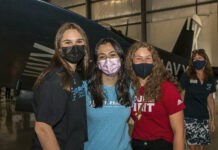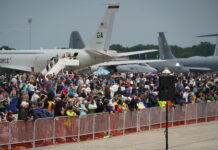Just a few weeks ago, ICAS and the California International Air Show (CIAS) hosted 22 ICAS members from 16 different air shows in the United States, Canada and Australia for the sixth ICAS Academy in the last four years. As has become the norm, participants raved about the depth of material covered, the informal atmosphere in which the material was presented, and the unique access given to Academy participants by the host show, in this case, the California International Air Show.
(As an aside and on behalf of all the people who have benefited from the ICAS Academy program since we started the program in 2000, ICAS would like to thank all six air shows that have hosted the Academy thus far: the Muskegon Air Fair, the MCAS Miramar Air Show, the Florida International Air Show, the NAS Oceana Air Show, the Rhode Island Air National Guard Open House and Air Show, and the California International Air Show.)
In 22 years, the California International Air Show has raised nearly $6 million for local charities and established itself as an annual event that has helped define and enrich Salinas, the city in which the air show is held each year. Representatives from CIAS have been trailblazers and leaders within the air show community from the show’s start in 1981. And the organization’s structure, history, philosophies, position within the community and reputation as an entertainment event all make it precisely the right subject for an ICAS Academy program.
Toward the end of the Academy’s eight-hour classroom session organized and conducted by past members of the CIAS Board of Directors, former CIAS President Don Chapin summarized his perspective on the show’s reputation within the community. “We’re a local fundraiser that just happens to be an air show,” he said…and the whole show suddenly made sense to me.
The California International Air Show is first and foremost a community event. It is secondly a fundraising event. And only then is it an aviation event. As such, it can solicit support from a broader cross-section of the local community. A few pilots are involved in the planning, management and execution of the show, but show management is dominated by local business owners, opinion leaders, and community activists.
And that distinction makes all the difference.
Though it’s held at the local airport, the show is not perceived as an airport event organized by and for aviation “types,” but as a fundraising event for local philanthropies that just happens to be held at the airport. That has allowed the show’s management to approach the best minds and most influential personalities in the community — not just those who happen to be interested in aviation – to help them produce and promote the air show which, in turn, has ensured that the show has been embraced by the entire community and not just the city’s aviation enthusiasts. That focus on “community” rather than “air show” has also allowed air show fundraisers to approach their business peers and social acquaintances in Salinas to urge their financial and organizational support of the event.
The result is a truly community-based event that is bigger, more important and more permanent than the capable group of people charged with running it each year. The California International Air Show has become community property, an event that the local area identifies as one of its community assets…an event that individuals and businesses support, in part, because they know that they’re supporting their own community when they support the community’s air show.
Not every air show can duplicate the manner in which CIAS has insinuated its show into the very fabric of the community. And, though proud of what they’ve accomplished, the individuals involved with the Salinas air show will be the first to tell you that their focus on community is not exactly a sophisticated concept. But in a time when so many shows are struggling to build a foundation on which they can build toward the future, the Salinas model should be something that every show considers, studies and – if possible – seeks to emulate.








